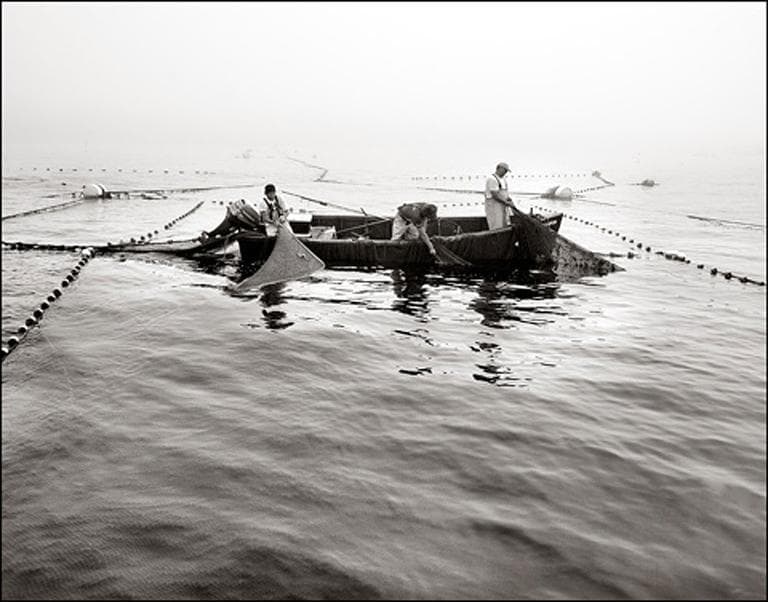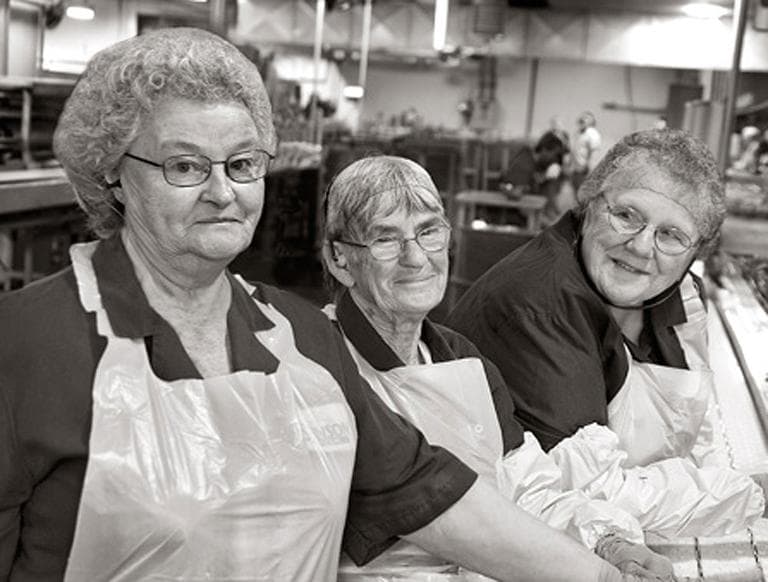Advertisement
'Capturing Community': Artist Documents New England's Dying Industries
ResumeCapturing Community: Farming, Fishing and Canning in New England
(Click an image to start slideshow)
Imagine a photograph. It's black and white, and a shimmering silver tone. Fog lifts off the ocean and wraps around a chain of wooden fishing boats in the center of the picture. Fishermen lean over the sides, gathering up nets by hand, pulling out the smudged gray shapes of fish they've caught in their long haul.
It is a classic, timeless New England image. But this one wasn't taken a century ago. Rather, it was captured very recently, by photographer Markham Starr.
Starr has spent several years documenting three dying New England industries: The trap fishermen off of Point Judith, R.I.; the dairy farms of his hometown, North Stowington, Conn.; and the last sardine cannery in America, the Stinson Seafood plant in Prospect Harbor, Maine, which shuttered its doors last year.
Starr's photographs are currently on display at the Tufts Art Gallery in a new exhibition: "Capturing Community: Farming, Fishing and Canning in New England."
"There are only four companies left trap fishing in Rhode Island," Starr said. "There used to be thousands. Now it's down to 50 people. A lot of the fleet has disappeared. It's just gone. They're cutting up the steel boats. The wooden boats are just dumpstered."

Starr was never a fishermen, but his family has a long history with the trade. His great grandfather started a fish-netting company that was handed down first to his grandfather and then to his father. But the business collapsed with the introduction of synthetic nets from Asia, making Starr a direct — if distant — victim of the same forces at work among the families he's documenting today.
"These young guys don't know how to mend the nets or build the traps," Starr said. "There's nobody who knows how to build the traps anymore. So I worry about which direction the country's going. All these people who produce things are rapidly disappearing, no matter what field they're in."
Disappearing, too, is their way of life. In Connecticut, there were 5,000 dairy farms in the 1940s. In 1995 there were 300. Today, just 152 farms remain.
"They're all small family run dairy farms. The elder farmers are reaching the end of their working careers. In most cases they don't have family that may take over, so it's up in the air as to what may happen," Starr said.
Which is why Starr's photographs also capture simple moments in the workers's lives. Farmers waking at 4:30 in the morning. A woman lifting great bales of hay. A cow alone in an old barn, vapors rising from its damp nose on a cold morning. They are snapshots of a circadian rhythm that feels foreign to many people today.
"Nobody documented what the average person was doing," Starr said. "These were people who love what they're doing. They can't imagine doing anything else."
And yet, they must.

The Stinson Seafood cannery in Prospect Harbor, Maine was the last sardine cannery in America. It closed last year. Starr said he heard about the shutdown from an NPR story. He drove up to Maine as fast as he could, and was allowed only a day-and-a-half to document a town whose entire way of life was about to vanish.
When he arrived, there were 20 women who canned all the fish — the fastest team there could pack 3,000 cans in a day.
One woman, Leela Anderson, had worked at the cannery for 54 years.
"I went up to interview her after the plant had closed. And she was trying to find a new job, at 78 years old," Starr remembers.
None of them wanted to stop working.
"One older gentlemen said that when he was hired by Stinson, as long as he could crawl through the door and wanted a job, there would be a job there for him ... you don't have that community feeling any more," Starr said.
In the towns around the Stinson plant, everyone knew someone who worked at the cannery, and most were stunned that an industry, which at one point had employed thousands of people, could disappear so completely.
We're living in an age where the visual image is ubiquitous and instant. Photographs have started to take on a feeling of impermanence. Yet Starr's pictures seem to do the opposite: they are memorials that exist as a permanent record of fading industries.
And while he may be telling the stories of New England's dying industries, Starr said he hopes he's doing more than simply "shouting in the dark."
Guest:
- Markham Starr, photographer
This segment aired on May 16, 2011.